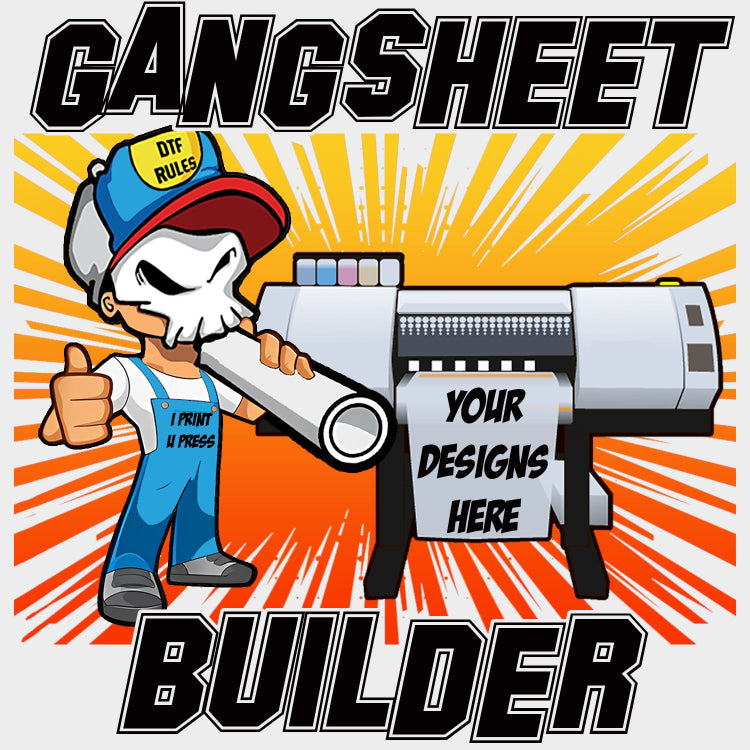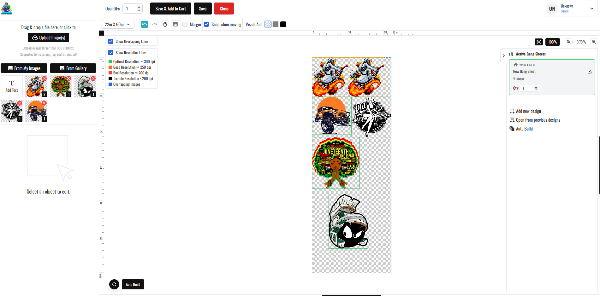DTF Junkie
Gang Sheet Builder
Gang Sheet Builder
Our DTF Gang Sheet Builder boasts a user-friendly easy to use interface, making it accessible to both beginners and experts. You don't need to be tech-savvy to create a Gang sheets. Tailor your gang sheets to your exact needs. Specify the size, orientation, and arrangement of your images. Easily import your designs in a PNG file format.
Wholesale priced, quality, soft feel DTF Gang Sheets. DTF Junkie offers Custom, full color and vibrant DTF (Direct-to-Film) Printing. Also as DTF Heat Transfers the cutting-edge solution that's transforming the way you apply stunning designs and graphics to your merch! Take your brand and graphic T-shirts to next level! Custom means we can print anything your mind creates or desires into a DTF Print. Full Color means no color limitations or extra fees for a vibrant colorful print. Soft Feel means- soft hand feel to the touch, stretchy, durable prints. Place your order now.
With over two years in the business DTF Junkie is one of the best DTF Printing companies out of the Sunshine State of Florida. Fast shipping out of Tampa, FL with one to two day turn around to the state of Florida and lower south eastern states.
Files must be print ready! High quality, (PNG, TIFF, PDF) files at 300 DPI with a transparent back ground. Please read our artwork submission policy here.
Share
Collapsible row
Collapsible row



Quick Links
DTF Junkie Artwork Submission Policy
Terms and Conditions for Artwork Submission and Printing
-
Introduction: These terms and conditions govern the submission of artwork for DTF printing services. By submitting your artwork, you agree to comply with and be bound by these terms.
-
Accuracy of Information: You, the submitter, are responsible for ensuring that all information provided in relation to the artwork submission is accurate, complete, and up-to-date.
-
Ownership and Rights: By submitting artwork, you confirm that you are the rightful owner of the intellectual property rights or have obtained the necessary permissions for the use of the artwork.
-
Content Guidelines: . We reserve the right to refuse any submission that does not meet our content guidelines.
-
Quality and Resolution: Submitted artwork should meet specified quality and resolution of a PNG, TIFF or PDF with a transparent background at 300 DPI requirements for printing. We are not responsible for any issues arising from poor quality or resolution.
-
Review and Approval: We reserve the right to review and approve or reject artwork submissions based on our discretion. Approval does not guarantee the absence of errors or quality issues.
-
Payment and Fees: Payment for printing services is required before the printing process begins. Additional fees may apply for corrections, revisions, or rush orders.
-
Delivery and Shipping: Delivery times and shipping costs are provided upon request. We are not responsible for delays or damages during transit.
-
Cancellation and Refunds: Once the printing process has commenced, cancellations are not accepted, and refunds will not be issued. Exceptions may be made in case of defects attributable to our services.
-
Limitation of Liability: Our liability is limited to the value of the printing services provided. We are not liable for any indirect, consequential, or incidental damages.
-
Changes to Terms and Conditions: We reserve the right to update or modify these terms and conditions at any time without prior notice. It is your responsibility to review the terms periodically.
-
Governing Law: These terms and conditions are governed by the laws of United States of America, and any disputes arising shall be resolved in accordance with these laws.
By submitting your artwork, you acknowledge that you have read, understood, and agreed to these terms and conditions.
DTF Sizing and Placement Chart for Kids

Shipping Policy
How many Prints Fit on a Gangsheet

Free DTF CMYK Printable Color Charts
Understanding the Color Models
Color is an essential element in design, and understanding how color works in different contexts is crucial for creating effective visuals. Two of the most commonly used color models are CMYK and RGB. While they both deal with color representation, they are used in very different ways and for different purposes. In this blog post, we'll dive into the differences between CMYK and RGB, their applications, and why it's important to use the correct one for your project.

The Basics of RGB
RGB stands for Red, Green, and Blue. This color model is based on light and is used primarily in digital displays, such as computer monitors, televisions, and smartphones. Here's a breakdown of the RGB model:
-
Additive Color Model: RGB is an additive color model, meaning that it creates color by combining different intensities of red, green, and blue light. When combined at their maximum levels, these three colors produce white light.
-
Color Mixing: In the RGB model, colors are created by varying the intensity of each of the three primary colors. For example, combining red and green light at full intensity produces yellow, while combining red and blue light produces magenta.
-
Applications: Since RGB is based on light, it is the standard color model used in digital displays and electronic devices. Anything viewed on a screen, including websites, digital art, and videos, uses the RGB color model.
The Basics of CMYK
CMYK stands for Cyan, Magenta, Yellow, and Key (Black). This color model is based on ink and is used in printing processes. Here's a closer look at the CMYK model:
-
Subtractive Color Model: CMYK is a subtractive color model, meaning it creates color by subtracting varying degrees of light absorbed by the ink. When combined, these inks absorb (or subtract) light, with black ink being used to enhance depth and detail.
-
Color Mixing: In the CMYK model, colors are created by overlaying different amounts of cyan, magenta, yellow, and black ink. For example, combining cyan and yellow inks produces green, while combining magenta and yellow inks produces red.
-
Applications: CMYK is the standard color model for printed materials, such as brochures, posters, business cards, and any other physical media. When preparing files for printing, designers convert RGB files to CMYK to ensure accurate color reproduction.
Key Differences Between RGB and CMYK
-
Color Range: RGB can produce a wider range of colors compared to CMYK. This is because RGB works with light, which has a broader spectrum than the inks used in CMYK printing. As a result, some colors visible on a screen may not be replicable in print.
-
Purpose and Use: RGB is used for digital media, where light is emitted directly from the screen. CMYK is used for print media, where inks are applied to paper and reflect light.
-
Color Creation: RGB uses an additive process to create colors by combining light, whereas CMYK uses a subtractive process by combining inks. This fundamental difference affects how colors are mixed and represented.
-
Black Representation: In RGB, black is created by the absence of light (0% red, 0% green, 0% blue). In CMYK, black is a separate ink (Key) added to enhance the depth and contrast of printed images.
Why the Difference Matters
Understanding the difference between RGB and CMYK is crucial for anyone involved in design or printing. Here are a few reasons why:
-
Accurate Color Reproduction: Using the correct color model ensures that your colors are reproduced accurately in the final medium. A design that looks vibrant on screen (RGB) may appear dull or incorrect when printed (CMYK) if not properly converted.
-
Professional Quality: For professional print jobs, providing files in the correct color model (CMYK) is essential. Printers require CMYK files to produce accurate and high-quality prints.
-
Efficiency: Converting between color models late in the design process can lead to delays and additional costs. Designing with the final medium in mind from the start can streamline the workflow and prevent issues.
Conclusion
Both CMYK and RGB are vital color models in the world of design, each serving a specific purpose. RGB is perfect for digital screens, offering a wide range of vibrant colors, while CMYK is essential for print, ensuring accurate color reproduction on paper. Understanding these differences and using the appropriate model for your project will help you achieve the best results, whether you're designing a website or printing a brochure. By mastering both RGB and CMYK, you can ensure your designs look stunning in any medium.


